Even if you filter your water with a whole home water filter, shower water filters have several benefits. In this post, we will break down the benefits of filtering your shower water, and offer 5 brands that stood out as we did our research.
Table of Contents
- Benefits of a shower filter
- The problem with chlorine and DBPs
- Showering and chloroform exposure
- Things to look out for when buying a shower filter
- The best shower water filters
- ProOne ProMax
- Culligan WSH-C125
- Why we like Culligan
- Raindrops Shower Head with Filter
- Aquasana AQ-4100
- Aquabliss SF100
- Final thoughts on the best shower water filters
A whole home water filtration system is an ideal way to filter all of the water you use at home. Whether it’s your drinking water, or the water you shower and bathe in, there are filter options available.
Isn’t filtering your shower water a little overkill? Isn’t it enough to just filter your drinking water? While I was also skeptical at first, a little research has convinced me of the benefits of filtering shower water. In this post, I’ll take a look at those benefits and offer my recommendations for the best shower filter systems available.
See also: The 5 Best At-Home Water Filters for Better Water Quality
The first thing to understand about the water you shower and bathe in is that it is normally pre-treated with chemicals such as chlorine to kill potential pathogens.
Sadly, these chemicals do not magically disappear after use. Instead, the water you’re using to get clean likely contains residues of chlorine and other disinfection by-products (DBPs).
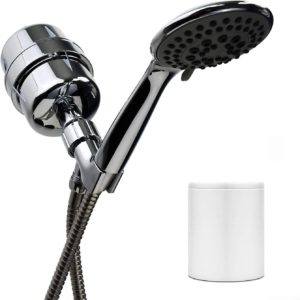
Best shower water filter
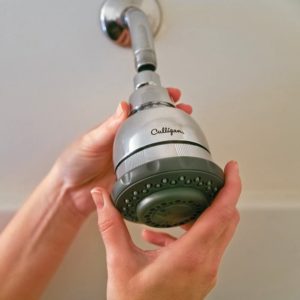
NSF certified shower water filter
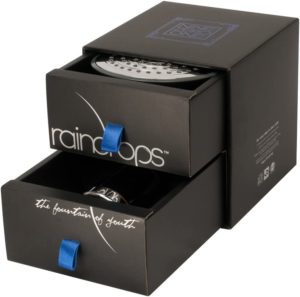
Another good option
Benefits of a shower filter
All in all, installing a complete home water filtration system, or single fixture water filters for your shower and bath water could have benefits including:
- Reducing skin irritation and dryness
- Relieving psoriasis and eczema
- Reducing scalp flakiness
- Improving hair shine and healthier
- Reducing frizziness
- Reducing exposure to bacteria
- Reducing chloroform exposure
Shower filters can effectively eliminate or reduce contaminants like chlorine and other DBPs.
They are also relatively inexpensive, especially compared to hair treatments, skin treatments, and medical costs. They are also super simple to install. For most products, just unscrew your current shower head, screw in the filter, then screw the shower head into the filter. Easy!
The problem with chlorine and DBPs
Showering in unfiltered water usually means exposing your body to disinfection by-products (DBPs), typically in the form of chloroform. Chloroform is a trihalomethane that exists at room temperature as a clear, colorless, heavy liquid with a specific odor you probably recognize from public swimming pools.
Chloroform is the most common trihalomethane in the water supply and is present both in tap water and well water. Swimming pools that rely on chlorination for disinfection also contain trihalomethanes as by-products. Chloroform is light sensitive and degrades in the presence of light and air. Chloroform concentrations in water systems are inconsistent and trihalomethane concentrations rise as water remains in the distribution system.
Other trihalomethanes include: bromodichloromethane, dibromochloromethane, and bromoform. Shower water may also be contaminated with haloacetic acids (HAAs; monochloroacetic acid, monobromoacetic acid, dibromoacetic acid, dichloroacetic acid, and trichloroacetic acid). Human exposure to these substances comes via ingestion, inhalation, and contact with the skin. And, rather worryingly, using hot water when showering, bathing, or doing the dishes appears to increase absorption.
So, while it’s smart to filter the water you drink, it may be even smarter to prioritize filtering your shower water.
Showering and chloroform exposure
The average adults is exposed to 0.199 to 1.89 μg of chloroform per kg of body weight every day, according to the World Health Organization.
Other estimates suggest that exposure could be higher than 3.0 μg/kg of body weight if you account for chloroform inhalation from air and ingestion from food (R, R). Chloroform is found in food, drinking water, and in the air.
The largest single source of exposure, however, seems to be showering and bathing.
Daily showering and bathing in unfiltered water increases chloroform exposure both through inhalation and through the skin. This is thought to add 0.36 to 3.4 μg/kg daily, with studies showing increased chloroform concentrations in the blood after using household water for showering, bathing, and even for doing the dishes by hand.
Specifically, blood chloroform concentrations increased by 2 to 7 times after showering; in one study, water levels of chloroform were 8 and 85 parts per billion, while blood concentrations after showering were 57 and 280 ppt (ng/L) (R).
One reason why showering and bathing seem to increase chloroform levels so significantly is that you absorb more chloroform through your skin from hot water. At bath-water temperatures of 30°C, volunteers in one study exhaled 0.2 μg of chloroform, versus 7 μg at the highest temperature (40°C) (R). In another study, the absorption of cytotoxic DBPs haloacetonitriles and chloral hydrate (CH) in human skin increased by approximately 50% to 170% when water temperatures increased from 25°C to 40°C (R).
Shockingly, one small study found that swimming for a couple of hours in a chlorinated pool could raise the average concentration of chloroform in breath to as much as 371 μg/m3 (R). Worryingly, chloroform and other potential contaminants in shower water, such as benzene, have been shown to pass through the placenta to an unborn fetus where they accumulate at a higher level than in maternal blood (R).
Things to look out for when buying a shower filter
When looking for a shower filter, check for certification by our old friends at the National Sanitation Foundation (NSF). An NSF/ANSI 42 certification means that the filter reduces aesthetic impurities such as chlorine and taste or odor. NSF/ANSI 177 certification is for shower filters that attach directly to the pipe in front of the showerhead and reduce free available chlorine.
You’ll probably notice that some shower filters mention vitamin C, which might seem a little odd. There’s good reason for this, however. Vitamin C (as sodium ascorbate or ascorbic acid) rapidly neutralizes chlorine. As such, vitamin C has become quite popular with sanitation engineers who need to quickly and safely dechlorinate waste water.
Even a little bit of chlorine residue in treated waste water can have devastating effects on local wildlife. Happily, vitamin C is not toxic to wildlife and does not lower the dissolved oxygen in water as much as sulfur-based chemicals. Ascorbic acid is mildly acidic and reacts with chlorine to form hydrochloric acid. Don’t worry, though, this has a negligible effect on the pH of the water exiting your shower head. And, if a system uses sodium ascorbate, this is neutral and does not affect the water pH.
The best shower water filters
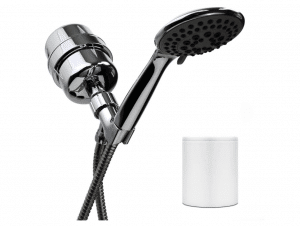
ProOne ProMax
Highlights: US-made shower filter that is NSF certified to NSF 42 and NSF 53, meaning your shower water will be drinking water quality. Also WaterSense certified and made with robust, durable materials in the U.S. [ProOne was formerly known as ProPur]
The ProOne ProMax is our top choice for a shower filter as it carries the most robust certifications and is much more sustainably made than almost all other shower filters.
This model comprises stainless steel and ABS plastic, with a BPA-free chrome finish and proprietary filter technology. It is made in the U.S. and is NSF certified to NSF 42 and NSF 53, meaning your shower water will be drinking water quality. This model is also EPA WaterSense certified and easy to install. It’s also easy to change filters, which you’ll want to do every 6-9 months, and the filters are inexpensive.
The ProOne ProMax reduces or removes over 200 potential contaminants, including:
- Volatile oil compounds (VOCs)
- Lead and other heavy metals
- Fluoride
- Pesticides and herbicides
- DBPs
- Chloramines
- Pharmaceuticals
- Micro-organisms.
The ProOne shower filter is available in standard white plastic and chrome options too, but we’d recommend the stainless steel version as it is arguably more robust and sustainable. You can also get this shower filter as a wall-mounted or wand-style set-up.
The ProOne Shower Filter has five spray settings with a massage swivel shower head rated at 2 gallons per minute (GPM). It fits standard 1/2-inch NPT, ISP and BSPT pipe threads and includes a 48″ Stainless Steel Flex Hose that is not plastic coated. The filters can last up to 9 months and contain no resins or beads, unlike the Aquabliss.

Culligan WSH-C125
Highlights: An NSF 177 and WaterSense certified water filter showerhead with 5 spray settings. Reduces 99% of chlorine, has an anti-clog design, and is inexpensive with low-cost replacement filters.
The Culligan WSH-C125 is a top pick for a showerhead water filter. This model is NSF certified to Standard 177, meaning it removes almost all chlorine (99%) and many other contaminants. Expect to see less scale build-up, enjoy softer water, and experience less sulfur odor after installing this filter. The filter media also helps limit bacterial growth and transfer.
The Culligan has five spray settings including a full body spray, soft rain, an invigorating pulse massage setting, and two combination settings. Because it reduces scale and chlorine, this showerhead filter is a great choice for anyone who has dry, itchy skin, a sensitive scalp, or dry, damaged hair.
The Culligan is also EPA WaterSense certified and provides 1.8 gallons per minute (GPM), which is unlikely to make your shower feel any less powerful. If you do find that the showerhead slows down flow a little too much, you can attempt to Macgyver the showerhead. Either remove the entire flow restrictor insert (not recommended) or remove the o-ring (the small gray ring) that encircles the flow restrictor. Removing this ring reduces the restrictor’s ability to affect pressure, meaning the volume of water passing through the showerhead increases. Note, however, that removing this ring or the restrictor means that the unit is no longer in compliance with the EPA Water Sense certification.
The Culligan is relatively easy to install as it screws in by hand in mere minutes and works with standard ½-inch threaded shower arms. You’ll need some plumbers’ tape (typically Teflon or other PTFE, alas), but it’s unlikely you’ll need any tools or assistance if you have decent grip strength and are somewhat handy. As with any new filter showerhead, run hot or cold water through the new filter for several minutes to clear loose filtration media and soak the filter. Check the filter is ready for primetime by turning the water off and on at full bore; if it runs clear, you’re good to go.
Each filter lasts around six months or 10,000 gallons, at which point the water flow will start to decline, telling you it’s time to switch the filter. The compatible WHR-14 filter cartridge is easy to replace and only costs around $8 per filter! (View on Amazon)
The only downsides to the showerhead are that it’s stationary and may mean getting rid of a perfectly good showerhead that might work with an in-line filter for years to come.
Why we like Culligan
Culligan was established in 1936 and provides water softening solutions for homes, offices, restaurants and industry worldwide. It offers drinking water systems, whole-house filtration systems and bottled water delivery. The company participates in disaster relief programs globally and locally through Culligan Cares™ and regularly partners with Convoy of Hope to provide clean water for those in need following a disaster.
Culligan has demonstrated a commitment to minimizing its impact on the environment through High Efficiency water conditioners and Energy Star® rated Bottle-Free® coolers that help reduce the use and disposal of plastic drinking water bottles.

Raindrops Shower Head with Filter
Highlights: A luxury shower water filter with NSF 42 certification to remove chlorine and some other contaminants. Easy to install, looks great, and can help relieve itchy skin and dry skin and hair due to chlorine and scale.
The Raindrops Shower Head with Filter is a more luxurious shower filter option to match spa-like bathroom aesthetics. Don’t let appearances deceive though; this shower filter is more than just a pretty face. It boasts a six-step filtration system certified by National Sanitation Foundation as ANSI 42, meaning that it can reduce aesthetic impurities such as chlorine and taste or odor.
This filter is popular with users who find that unfiltered shower water causes dry, itchy skin and dry, damaged hair. Note, though, that this filter is not certified to remove other impurities, despite the company claiming that it can reduce heavy metals including lead, copper, iron, and mercury, fluoride, and bacteria. If you’re on a well water system and find that your shower tends to stain blue or red, this shower filter is likely a good option.
Like many of the best shower filters, this one uses Kinetic Degradation Fluxion (KDF). A KDF filter contains a high-purity copper-zinc formulation that removes chlorine, lead, mercury, iron, and hydrogen sulfide from water through a basic redox reaction (where electrons are exchanged with contaminants). It may also help to control microorganisms in water that is already potable (acceptable for drinking). To be fully effective, the water running through this filter media should be at a pH of 6.5 to 8.5 and at a temperature of 35°F to 212°F.
You don’t need any tools to install the Raindrops shower filter; just screw it in with some plumber’s tape. Each filter lasts for around six months or 12,000 gallons. Raindrops offers a scheduled filter replacement program to make sure you stay on top of things (and get a discount!).
The Raindrops filter is 5 inches long and fits US national standard ¾-inch NPT pipe thread. If you’re starting out, look for a bundle containing the Raindrops showerhead, the housing for the filter, and a replenishment KDF filter insert cartridge. If you already have a compatible showerhead, you can purchase the filter and housing separately here.
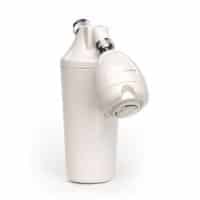
Aquasana AQ-4100
Highlights: One of the best two-stage shower water filters with in-line and shower head filtering at 2.5 GPM – meaning no loss of water pressure! The activated carbon filters last six months or 10,000 gallons and the system is NSF certified for chlorine removal. Also removes other common contaminants such as pesticides, lead, iron, and VOCs, but replacement filters are expensive and involve unnecessary plastic, and the whole unit is rather unattractive and won’t work with other showerheads.
The Aquasana AQ-4100 is one of the most effective two-stage shower water filters around. It offers both in-line and showerhead filtration and is certified by the National Sanitation Foundation (NSF), unlike most shower water filters on the market.
The filtration media is AquaSorb HX, a coconut shell-derived activated carbon that can remove chlorine, pesticides, lead, iron, and volatile organic compounds (VOCs). The system is third-party tested and certified by ANSI/NSF to Standard 42. This means it can remove 90% of chlorine in water as an in-line filter (rather than as a showerhead filter like the Culligan WSH-C125). It is also NSF 61 certified for material safety, but isn’t NSF 53 certified for potable (drinking) water, unlike the ProOne ProMax.
The Aquasana filters are a little pricier than some other filters, but they last quite a bit longer, to 10,000 gallons or six months. That means you’re looking at maintenance costs for filter replacement of around $100 annually, with just two filter changes a year.
The Aquasana AQ-4100 is relatively easy to install, with a simple screw-in design and four-step process, though you’ll need to use Teflon tape or similar (provided) and likely a wrench (not provided). Unlike many other water filters, this system totally replaces your current showerhead. While this means you won’t have to deal with incompatibility between a new filter and your current showerhead, it does mean replacing your existing showerhead, which may be unnecessarily wasteful and not to your taste.
Every system comes with a 1-year limited warranty in case of a manufacturing defect. With Aquasana, though, that’s unlikely, given the company’s longstanding leadership in water filtration.
The showerhead offers four massage settings and helps to neutralize the water pH. The upflow design keeps clogs at bay, so water flow doesn’t slow until you’re really close to the six-month filter lifespan.
With a 2.5 GPM flow rate, the Aquasana lets you continue enjoying powerful showers without worries over water contaminants. This flow rate is the maximum allowed in the U.S. and is higher than the WaterSense GPM of 2.00, meaning this isn’t a water-saving showerhead. Aquasana also offers a very similar filter with a 1.75 GPM flow rate that is WaterSense certified.
Despite its excellent performance, there are a few downsides to this filter. First, it’s not especially attractive. Made of white plastic, this will look somewhat out of place in a high-end, luxury bathroom aesthetic. Other downsides include pricier cartridges, with replacements involving switching out almost the entire base unit. This seems hugely wasteful and unnecessary, with other brands like Aquabliss designed so you just switch the carbon filter, not the whole unit. Oh, and the whole unit weighs about 3 lb., which is about twice as much as the Aquabliss.
All in all, the Aquasana AQ-4100 is an efficient, certified, relatively straightforward shower water filter, but it’s definitely got room for improvement.
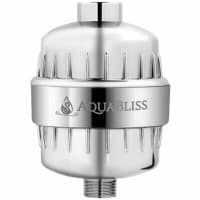
Aquabliss SF100
Highlights: An unobtrusive, efficient, easy-to-install shower water filter that works with most showerheads. Includes activated carbon and a range of other filtration media. Rave reviews online but not NSF certified.
The Aquabliss is a popular choice for a shower water filter, as it is compatible with almost every showerhead, includes a range of tried and tested filtration media, and offers inexpensive and easy filter replacements. This in-line filter also weighs about half as much as the Aquasana AQ-4100 at just 1.6 lb. and most likely works with your existing showerhead, unlike the Aquasana which only works with the matching showerhead. This is a lot less wasteful overall and means you can keep using your preferred showerhead without disruption!
Speaking of waste, the Aquabliss doesn’t require you to switch out almost the entire system when replacing a filter. Instead, you just replace the inside filter for about $15 every six months or 10,000 gallons.
Like the Aquasana, the Aquabliss uses some mineral filtration plus activated carbon, along with vitamins and clays to neturalize and bind contaminants. Unlike the Aquasana, the Aquabliss is not NSF certified or third-party tested, which is real shame. Given the reviews online, it seems this shower water filter makes a big difference to water quality for many users, so it would be great to see the company undertake third-party testing. That this big company hasn’t done so suggests to me that Aquabliss is worried its filter wouldn’t meet the NSF standard.
Unlike the Aquasana, the Aquabliss screws in by hand with a little Teflon tape (included). The Aquabliss has a flow rate of 2 GPM, which is less than the Aquasana’s 2.5 GPM flow rate but shouldn’t compromise your shower’s water pressure much at all. Interestingly, while a flow rate of 2.00 GPM or less can earn a WaterSense water saving approval, the Aquabliss doesn’t seem to have this certification either. If that’s important to you, the Culligan WSH-C125 is a better choice (it’s also just a better choice overall!).
If a lack of NSF certification doesn’t phase you, the Aquabliss is likely a great choice for a shower water filter. Simple, low cost, easy to maintain, and compatible with most showerheads, this is a very popular model.
Final thoughts on the best shower water filters
If you want the most robust showerhead filter with the best certifications, the ProOne ProMax™ is the clear winner, carrying NSF 53 and 42 certifications. The Raindrops showerhead is also a good option, carrying NSF certification while looking great. The Raindrops filters are expensive though and tend to need replacing more often. The Culligan showerhead is another top choice, with NSF certification and low-cost filter replacements.
If you don’t much care about aesthetics, but do care about certifications and want higher water flow, the Aquasana AQ-4100 in-line and showerhead filter is a good choice. And if you want a simple, cheap, seemingly effective but uncertified in-line filter to work with your existing showerhead, the Aquabliss is a top choice.
In short, probably not. These strips can be wildly inaccurate and rely on subjective interpretation of colors, often giving you just a few seconds to match a color to a reference chart. The strips also don’t tell you all that much, even when they do work. Sure, they can let you know your water’s pH and if you’ve got the more egregious contaminants, like lead, in your water, but these strips can’t tell you the concentration. All in all, consider home test kits as an inexpensive initial screening tool that can help put your mind at rest or identify the need for more robust testing.
Nope. While many home test kits claim to test water to EPA standards, the Environmental Protection Agency doesn’t actually evaluate these kits, nor does it recommend them.
It’s worth noting that while several reviews online suggest no difference between water tested before and after installing the Aquasana AQ-4100 and some other shower water filters, those kinds of home tests can be wildly inaccurate and subject to interpretation. If a system has been certified to NSF standards, consider this much more robust and meaningful than any home test kits.
Most good shower water filters last for around 10,000 or 12,000 gallons, which works out to about six months of near daily showers for one person. Replace the filter every five months for a household of two, every four months for households of three, and every three months for households of four or more.
I live in Lake Havasu City Arizona. Since I have lived here I have dealt with a horrible rash and loss of hair. I have repeatedly said it was the water but people I talked to downplay it. It is nice to read an article that actually validates how dangerous our water is
Can you transfer the whole house water filtration system to another house if you move?
Hi Laurie,
Great question! In most cases, yes, it shouldn’t be too tricky to uninstall a whole house water filtration system and reinstall it in your new home.
Leigh